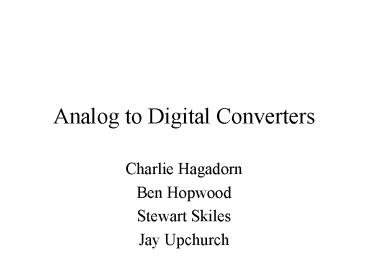Analog to Digital Converters - PowerPoint PPT Presentation
1 / 39
Title:
Analog to Digital Converters
Description:
The real world is analog, but computers are digital ... Thermocouples. Strain Gage. Pressure Transducers. Digital Music Recording. Digital Speedometer ... – PowerPoint PPT presentation
Number of Views:125
Avg rating:3.0/5.0
Title: Analog to Digital Converters
1
Analog to Digital Converters
- Charlie Hagadorn
- Ben Hopwood
- Stewart Skiles
- Jay Upchurch
2
What is ADC?
- The real world is analog, but computers are
digital - ADC converts analog information to digital
information - Analog signals contain an infinite amount of data
- ADC samples the data and splits it into finite
information.
3
Basic ADC Conversion
7 6 5 4 3 2 1 0
Amplitude
1 2 3 4 5 6 7 8
Time
4
ADC Constraints
- Resolution
- Speed
- Cost
- As with any engineering system these constraints
are dependant on each other. Trade-offs must be
made.
5
Types of A/D Converters
- Dual slope integrating converters
- Successive-approximation converters
- Flash (Parallel) converters
- Voltage to frequency converters
- Ramp converters
6
What makes a good ADC?
- High resolution
- High speed
- Low cost
Generally, in order to improve one of these
aspects, you must degrade one or more of the
others.
7
Dual Slope Integrating
8
Advantages
- High resolution (10-20 bits)
- Excellent accuracy (0.01 or better)
- Excellent noise immunity
- Low cost
- Excellent stability (time and temperature)
9
Disadvantages
- Slow (1-10/s)
10
Uses
- Voltmeters
- Digital panel meters
- Digital multimeters
- Etc.
11
Successive-Approximation
12
Advantages
- Higher speed (10-105/s)
- Good accuracy (0.1 typ)
- Reliable conversion technique
- Medium resolution (8-12 bits)
13
Disadvantages
- Highly susceptible to noise (must prefilter)
- Higher cost than dual slope integrating
converters - Accuracy limited by D/A converter
14
Uses
- Signal processing
- Applications where the input signal is
continuously varying at relatively high speed - Applications where several inputs entered in
rapid succession
15
Flash (Parallel)
16
Advantages
- Very fast (4-1000ns), useful for high speed
applications
17
Disadvantages
- Poor resolution (4-10 bits)
- High cost (150 for 6 bits, 3000 for 10 bits)
- Cost becomes a major factor over 6 bits
18
Voltage to Frequency
19
Advantages
- Excellent noise reduction
Disadvantages
- Slow
- Generally limited to 10 bits or less
20
Uses
- Digital voltmeters
- Digital multimeters
- Applications requiring good noise reduction but
not good speed
21
Ramp Converters
22
Advantages
- Fast
- Medium resolution (8-12 bits)
Disadvantages
- Requires highly accurate ramp source
23
Comparison
24
A/D Subsystem
4 Modes of Operation
Single Channel Single Channel 4-Channel 4-Chann
el
4 Consecutive Conversions Continuous
Conversions 1 Conversion Each Continuous
Conversions
Each conversion is stored in 1 of 4 registers.
25
Single Channel, 4 Consecutive Conversions
Set MULT 0 (for single channel) and SCAN 0
(for consecutive)
Single Channel, Continuous Conversions
Set MULT 0 (for single channel) and SCAN 1
(for continuous)
Overwrite ADRs
26
Multi-Channel, 1 Conversion Each
Set MULT 1 (for multi-channel) and SCAN 0
(for consecutive)
then
then
then
Stop
Multi-Channel, Continuous Conversions
Set MULT 1 (for multi-channel) and SCAN 1
(for continuous)
Overwrite ADRs
27
A/D Converter Registers
1031 - 1034
4, 8 Bit A/D Result Registers
Option Register
1039
ADPU
CSEL
DLY
Startup Delay Bit
0 for E Clock 1 for Internal R-C Clock
A/D Powerup
Use Internal R-C Clock when E Clock Frequency is
below 750 kHz
28
Single Channel Selection
ADCTL Bits 3-0
29
Multi-Channel Selection
ADCTL Bits 3-2
30
A/D Wait and Stop Modes
- During Wait Mode
- All A/D conversion stops
- Immediately After Wait Mode
- Re-sampling begins
- A/D circuits are stable and conversions are
accurate
- During Stop Mode
- All A/D conversion stops
- Immediately After Stop Mode
- Re-sampling begins
- A/D circuits are unstable
- If DLY is of Option Register is set, conversion
is stable - Otherwise, conversion stabilizes after 100
microseconds
31
A/D Converter Characteristics
- Linearity to ½ LSB for VRL 0V to VRH VDD
- Monotonicity Guaranteed (conversion result never
decreases - with an increasing input voltage)
- Maximum Difference VRH VRL 5V
- A/D system stabilization delay after power-up or
stop is - is about 100 microseconds.
- Sample and hold capability
32
(No Transcript)
33
Example of ADC
- Using Successive Approximation
34
Example Problem
- Problem Statement
- Successive Approximation ADC
- 10-bit resolution or 0.0009765625 of Vref
- Vin0.6 Volt and Vref 1 Volt
- Find digital value of Vin
35
Example Problem
- Solution
- Divide Vref by 2 and Compare Vref/2 with Vin
- If Vin is greater, turn MSB ON
- If Vin is less than Vref/2, turn MSB OFF
36
Example Problem
- Calculate the state of MSB
- Compare Vin0.6 V and V Vref/2 0.5V
- 0.6 gt 0.5, thus
- MSB 1
- Calculate the state of MSB-1
- Compare Vin and (Vref/2 Vref/4)
- 0.6V and (0.5 0.25) 0.75V
- Because 0.6 lt 0.75, MSB-1 is turned off
- MSB-1 0
37
Example Problem
- Calculate the state of MSB-2
- Go back to last voltage value that cause an ON
(0.5V) and add Vref/8 and compare with Vin. - Vin and (.5 Vref/8) 0.625
- Vin lt 0.625
- MSB-2 is turned off
- MSB-2 O
38
Example Problem
- Calculate the state of MSB-3
- Go back to last voltage value that cause an ON
(0.5V) and add Vref/16 and compare with Vin. - Vin and (.5 Vref/16) 0.5625
- Vin gt 0.5625
- MSB-3 is turned ON
- MSB-3 1
39
Examples of ADC Applications
- Thermocouples
- Strain Gage
- Pressure Transducers
- Digital Music Recording
- Digital Speedometer






























